Projection Television Sets
Projection Television Sets

(Translation of German article Projektions-Fernsehgeräte by Franz Born)

Part 1: Self-Contained Projection Sets
In the early 1950s, picture tube technology was not yet mature. In the first TVs after the war, the state of the art was a direct-view picture tube with a 70° deflection angle and a 36 cm diagonally measured picture size. Within a few years there were 70° picture tubes with 43 cm and 53 cm diagonal screen size. Sets using the larger tubes ended up having unwieldy cabinet shapes. The use of 90° picture tubes in 1957 and 110° tubes in 1959 helped solve this problem.

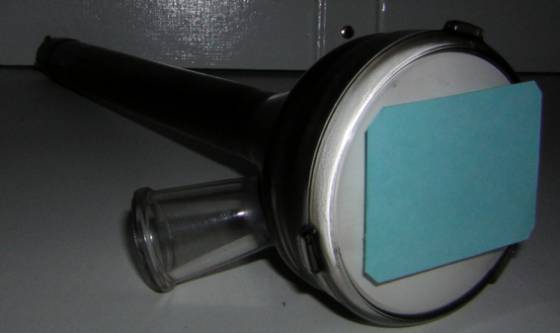
TD 1419 MW 6-2 (mask illustrates picture size)
Philips began mass production of TV sets with the CCIR standard in 1952. These sets included the TD1410 and TD 1419 with the above mentioned 36 cm direct-view picture tube, with a viewable image size of about 29 x 22 cm. However, already in 1952, the TD 2312 was developed. The latter model was a self-contained projection set (rear projection set)! This set offered a nearly rectangular and flat screen with an image size of about 46 x 36 cm! The actual picture tube in this set is a round tube with a diameter of 6 cm (MW 6-2).



The heart of this set is a Schmidt optical system, into which the picture tube is integrated. After passing through a corrective lens, the light rays reflect off a 45° mirror in the upper part of the housing and travel from there to the projection screen. A black fabric shroud was used between the Schmidt optical assembly and the divider wall for the upper part of the cabinet to prevent interference from stray light. The projection screen was made out of unbreakable (plastic) material with a special grating surface on both sides.

High Voltage Unit Projection Diagram
Another unusual feature of this set is a separate high voltage unit. To achieve the necessary brightness for the approximately 4.8 x 3.6 cm picture on the MW 6-2, an anode voltage of 25 kV is required!
A 1 kHz oscillator signal is converted to a sawtooth waveform and fed to two parallel output tubes (UL44). The flyback part of the waveform (with an effective frequency of about 30 kHz) is fed into an oil-immersed transformer. Included within the assembly are various capacitors and 3 rectifier tubes (EY51) which are deployed in a cascade circuit to develop the high voltage. A regulator circuit stabilizes the 25 kV, depending on the load.
In addition, within the high voltage unit there are circuits for generating the DC voltage for the focus coil and the negative blocking voltage for the protection circuit. This protection circuit, which uses a DAF41, is necessary to prevent burn-in (due to high brightness) on the small screen in the event of component failure.
Outside of these unusual features, the set has a standard Stockholm chassis for that model year. There were modifications in the appropriate parts of the circuitry -- the deflection output circuitry was modified due to the different deflection angle, and the unnecessary HV circuitry was left out. In most sets, a tuner was included for channels 5 - 10; in place of the lower band there was a continuously tunable VHF-FM tuner. At that time, this was a wecome solution, since most FM receivers were just converters, while the TD 2312 included a high quality audio receiver. For this purpose the set had a switch which could be used to switch off the unnecessary sections of the circuitry when the set was just being used for radio reception.
Watching TV with a projection set is something special. In a decently lighted environment, one can enjoy watching an especially good picture. In order to achieve this, the projection screen had to be approximately at eye level, and viewers could not be spread apart too far, since the viewing angle was limited. Other sets using Schmidt optics were brought to market in the 1950s. Among these were TV wall projectors, but that's another story.
Attachments:
- Schmidt-Optics Diagram (20 kb)
- Optical Ray Diagram (10 kb)
To thank the Author because you find the post helpful or well done.
Projection TVs - Part 2

(Translation of German text by Franz Born)

"Beamers" of the 1950s
In the mid 1950s, few households could afford a TV. That frequently led to situations where a number of people gathered in front of the small screen in someone's living room or the window of a radio shop. For example, I can remember watching the broadcast of the crowning of the English queen. At that time, it was one of the first major TV broadcast events. Groups of men also liked to watch Soccer broadcasts together in groups -- with a little beer. That didn't go so well if the host had nothing better than a small-screen TV to offer.
The TV industry was quick to fill this gap with the available technology of the time. In 1956, Philips came out with the model VE 2600 -- a 30 tube projection TV.


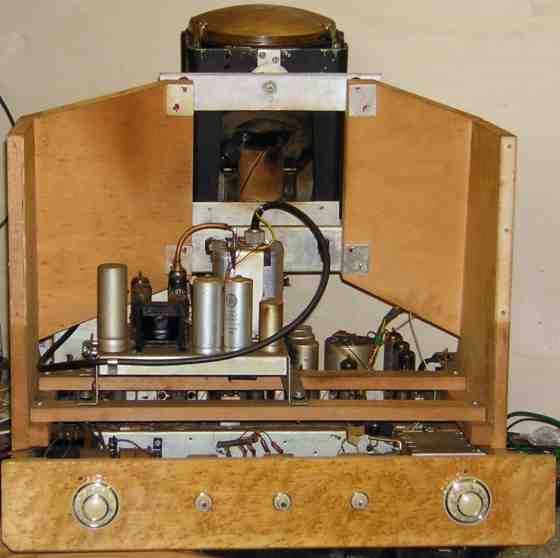
Interior view of the VE 2600. Speaker baffle removed in right photo.
This model was a modified 53 cm table set. In the same cabinet, in place of the picture tube there is a wooden superstructure on which a Schmidt optics assembly and a separate high voltage unit are mounted. Both units were already proven performers in self-contained projection sets for years. By using a different corrective lens than the self-contained sets had, a 1.6 x 1.2 m image could be projected on a screen 3 m away. Admittedly, the room had to be fairly dark; otherwise -- just like a photographic slide show -- the picture was not bright enough.
The technology was closest in similarity to direct view TVs with the C2 chassis. The IF stages used the latest intercarrier technology with its higher IF frequency.
The performance limitations (focus variations with varying beam current) were not particularly severe for self-contained projection sets; for wall projectors, however, the issue was more serious.
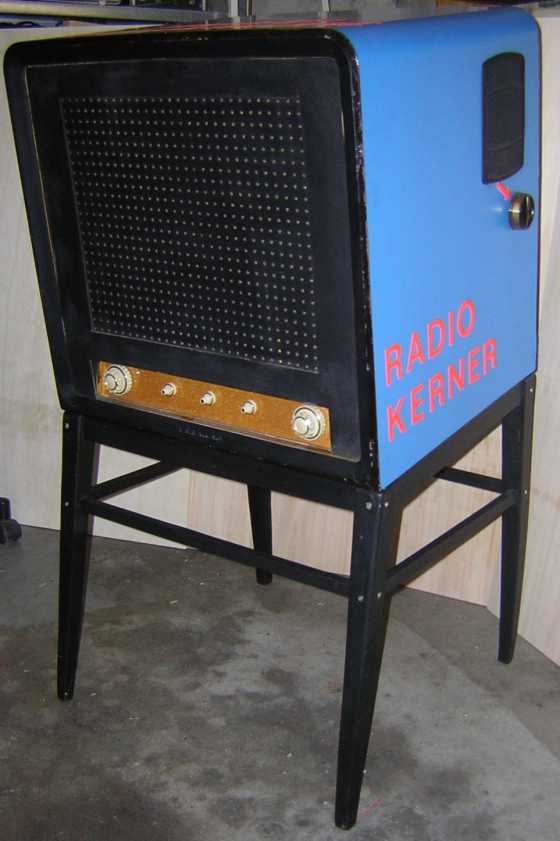
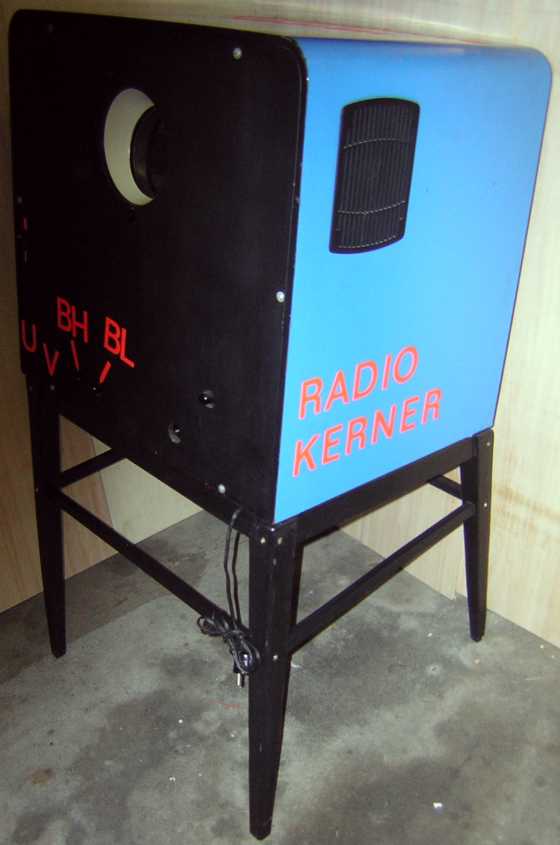
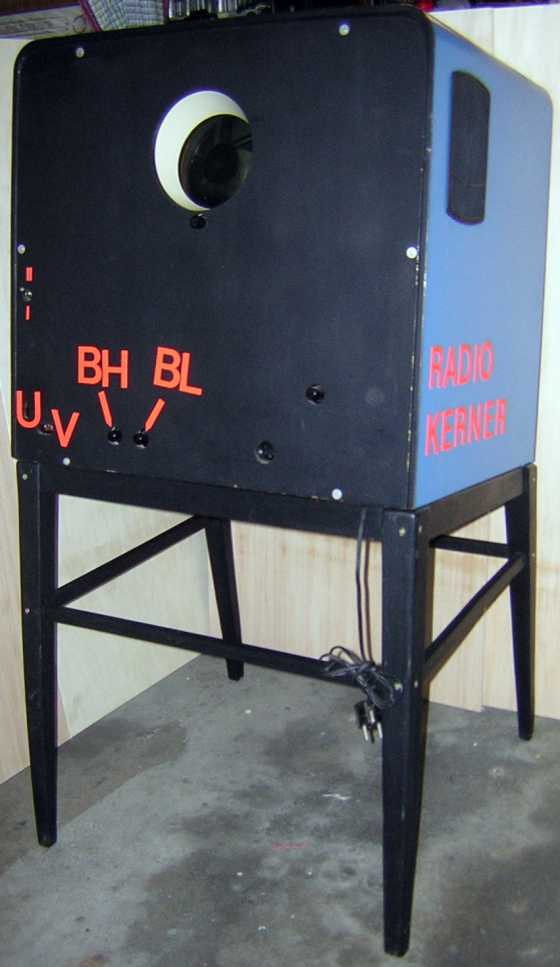
A dealer in Cologne used his VE 2600 for advertising
Because demand for wall projection TVs arose again in the 1960s, Philips brought the much-improved model VE 2609 to the market in 1961.
The most obvious change was the cabinet. It was made of metal, similar to a large oscilloscope. Since it had carrying handles, it was suitable for portable usage. But there were also a few technical changes. It had two vertical chassis sections with printed circuits, both VHF and UHF tuners, and most importantly, it had an improved focus control system.
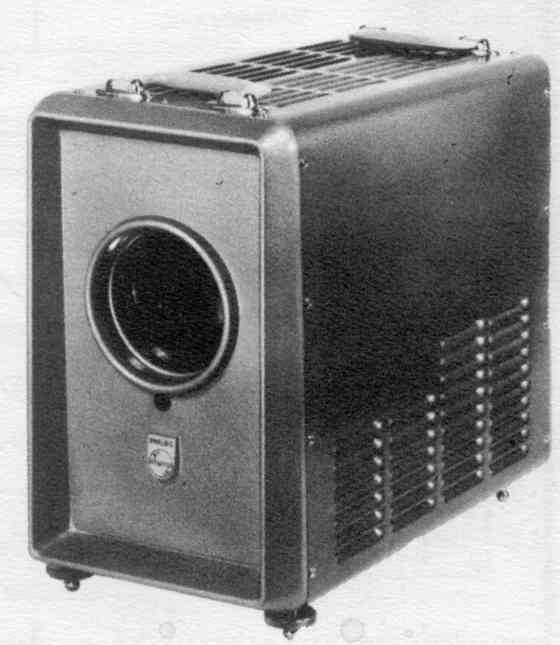
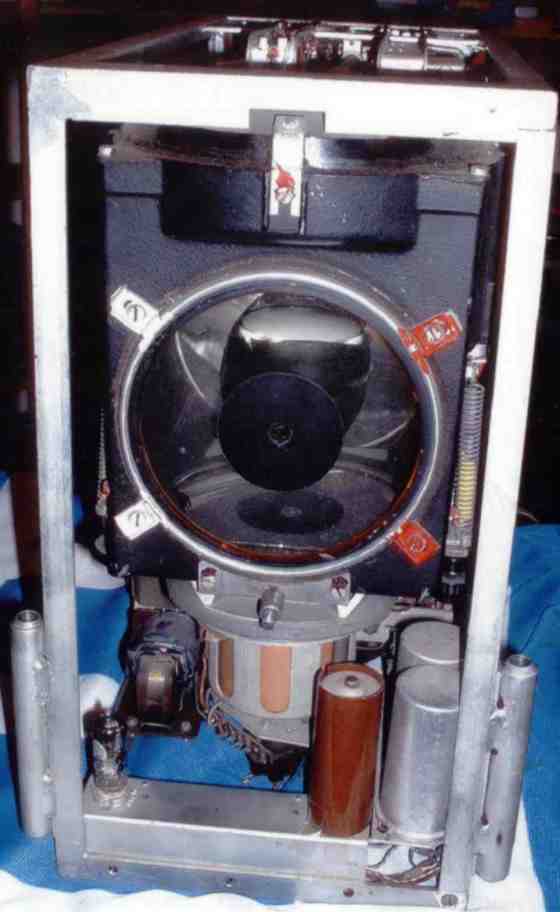


These pictures of the VE 2609 show its compact design
Other manufacturers also brought TV wall projectors with Schmidt optics to market at that time.

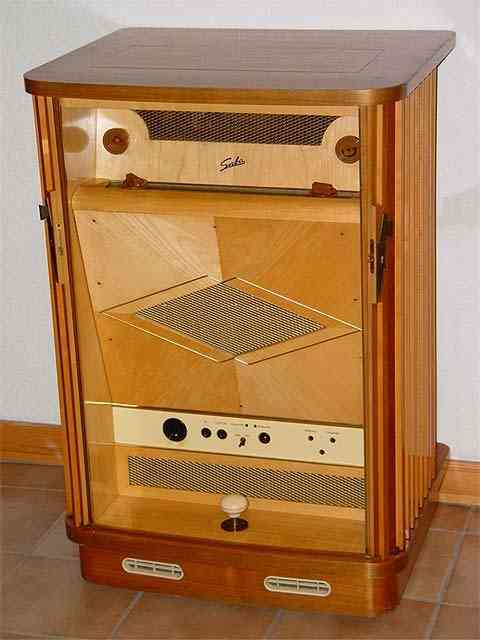

Shown above is the Saba Telerama P 716
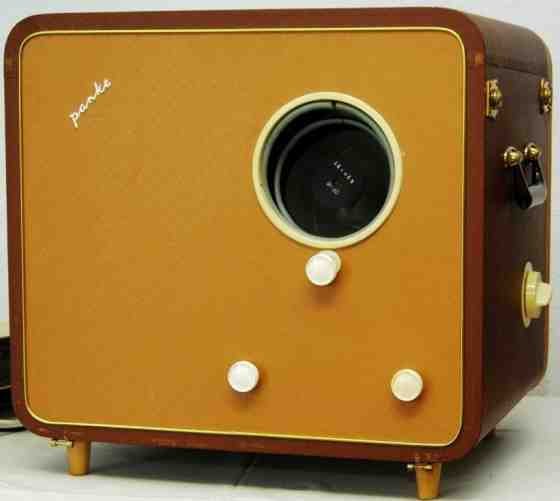


Stern Radio Berlin also came out with the compact beamer shown here -- the Panke model
Our collector-colleague Mario Spitzer has contributed a detailed article about this set.
To thank the Author because you find the post helpful or well done.
Projection TVs - How and Why

(Translation of German text by Ernst Erb)

Wall-projection TVs never really achieved the same level of market success that modern "beamers" have; yet they were an interesting solution for increasing the size of the projected picture. Whoever is interested in this topic should also read Franz Born's article (shown above in this English thread) - and other articles are likely to follow.
Wolfgang Scheida has contributed various articles on the topic of TVs -- including, for example a List of East German TVs,a List of Austrian TVs, and a list of early German TVs. The following is a link to the not yet fully completed article Replica of an early TV set. Here you can find the History of the Moskwitch T1 (Soviet TV from 1947). For the case of articles about a specific model, you can click on Modellseite ("to the model") which can be found above the text of the article. The same holds true for the Einheits-Fernsehempfänger E1 (German "Unity" TV receiver E1 from 1939) -- about which you can find various articles.
You can check the current status of information on this subject by using the "Advanced Search" box, where you can select information by model.
To thank the Author because you find the post helpful or well done.
American projection TVs

During the early years of television, American manufacturers brought a variety of projection TVs to market.
The Problem with Early Large Screen CRTs
While small CRTs could be mounted within cabinets of reasonable size and shape, the small deflection angles (typically 40 - 70 degrees) used with early large screen CRTs meant that these tubes were very long. Mounting them in the usual direct viewing configuration resulted in cabinet depths that were excessive. To solve this problem, there were at least two creative solutions. A number of early TV sets with relatively large screens adopted the "mirror in lid" approach, as used in the RCA TRK12 TV in 1939. Its 12-inch diameter CRT was mounted vertically within the cabinet, with the screen facing upwards. Opening the lid revealed a mirror which allowed the screen to be viewed.

RCA TRK12 (1939) - photo by permission of Chuck A, www.myvintagetv.com
While this provided for a cabinet of reasonable depth, the position of the mirror is a bit too high off the floor for comfortable viewing. Another more radical approach was used by DuMont in the RA-101, with its huge 20-inch 20BP4 CRT (the largest availabe when this set was sold in 1946-48, with an overall length of 28 inches).

.jpg)
DuMont RA-101 closed (left) and open (right)
In this set, the CRT is stored vertically (screen up) when the cabinet is closed. When the doors are opened, a motorized mechanism tilts the CRT and its surrounding enclosure into a horizontal position, allowing direct viewing of the large screen at a comfortable height. However, this set, with its 20-inch tube and complex mechanism, was one of the most expensive TVs of all time, selling for $2495 in the 1940s -- an amount equivalent to something like 10 times that amount in dollars today.
Projection: A Cheaper and More Compact Solution
Use of various projection optical systems, including the Schmidt optical system mentioned above by Franz Born, allowed a large screen in a more compact cabinet than could be achieved with a large diameter direct-view CRT. Starting in 1947, RCA introduced a number of projections sets, all with a common optical system that projected a 25 x 19 inch picture on the rear of the viewing screen.



RCA 648PTK (1947) RCA 741PCS (1948) RCA 9PC41 (1949)
All three RCA photos by permission of Chuck A, www.myvintagetv.com
The Philips projection units described by Franz Born above were actually used in U.S. TVs before they were introduced in Europe by Philips in the TD 2312 (1952). In U.S. TVs, these projection units were referred to as Norelco "Protelgram" units (with 3NP4 3-inch CRT), which were used by several U.S. manufacturers including FADA and Emerson.
The FADA 880 combined an RCA 630TS chassis with the Protelgram projection unit.
.jpg)

FADA 880 (1949) Inside view, with Norelco Protelgram Projection Unit
photos by permission of Chuck A, www.myvintagetv.com
The Emerson 609 also used the Norelco projection system.
 photo by permission of Chuck A, www.myvintagetv.com
photo by permission of Chuck A, www.myvintagetv.com
Emerson 609 (1949)
USTV was another manufacturer which marketed projections sets, using their own (non-Schmidt type) projection optics and a 5TP4 5-inch CRT.


USTV T-525 (1947) inside view, with projection optics visible
photos by permission of Chuck A, www.myvintagetv.com
While all of the above projection sets are rear projection sets (as seen on most modern projection big-screen TVs), Philco used a highly innovative Modified Schmidt Optics in a front projection system in its model 48-2500. A highly reflective Micro-Lens screen on the bottom of the tilt-up lid has a slightly cylindrical shape, and provides a remarkably bright image over a field of view which is quite narrow vertically (viewers must be at normal seated height), but somewhat wider horizontally (to accommodate viewing from various positions in front of the set).


Philco 48-2500 (1948) Optics diagram
The complex optical path for the image begins on the face of the 4-inch diameter TP400 CRT, and bounces off the spherical mirror, traveling through a plastic corrective lens (through which the neck of the CRT protrudes) to a keystone mirror mounted against the inside surface of the front of the cabinet. From there the image travels to the front of the viewing screen. This unusual path requires that the image on the face of the CRT actually have a distorted "keystone" (trapezoidal) shape, which is accomplished by magnets attached to the side of the CRT itself, as well as special scanning waveforms. After the image travels through the asymmetric path, it appears as a correct rectangular image on the viewing screen.
.jpg)

TP400 with keystone adjustment magnets Spherical projection mirror
The spherical mirror has a black nonreflective spot in its center to prevent reflections back to the face of the CRT. The projection unit is shown below.
.jpg)
.jpg)

Projection unit with mirror removed (left); with mirror attached (center); and top view with plastic corrective lens over opening (right)
A rear view of the set shows the complete projection unit mounted within the set along with the main chassis. Although the focus stability of this set is not outstanding, picture quality can be quite adequate, especially if one does not get too greedy with adjustment for too much brightness or contrast.
.jpg)
.jpg)
Projection unit on left below speaker Image projected on the screen
Projection TVs fell out of favor by the early 1950s, when 16-, 17-, 19-, and 21-inch direct fiew CRTs with high deflection angles (and therefore more compact cabinet sizes) became available. Although the pictures on projection TVs are watchable, they do not match the image quality on direct view CRTs of the same era. Viewing angle is naturally far superior on direct-view CRTs as well. Nonetheless, projection TVs played an important role in providing reasonably affordable compact TVs with large viewable images during the late 1940s.
To thank the Author because you find the post helpful or well done.

To thank the Author because you find the post helpful or well done.
A more accurate dating of Protelgram

The Protelgram television projection system was advertised by Norelco, North American Philips, since 1948. Here is the ad from the second cover of Electronics, October 1948. According to Sibley, the 3NP4 projection CRT evidenced in the ad was registered in USA by the same Norelco in March 1948.
To thank the Author because you find the post helpful or well done.